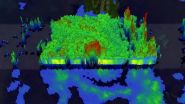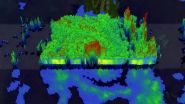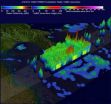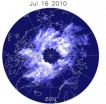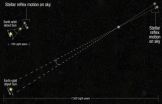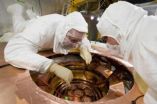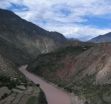(Press-News.org) VIDEO:
On April 9, NASA's TRMM saw powerful storms in Ita's eye wall reached heights of over 14 km/8.7 miles. The tallest thunderstorm towers reached heights of over 16 km/9.9 miles...
Click here for more information.
Tropical Cyclone Ita has been strengthening over the last two days and by April 10, Ita had become a major hurricane in the Coral Sea when NASA's Terra satellite passed overhead.
Ita's maximum sustained winds were near 115 knots/132 mph/213 kph on April 10 at 0900 UTV/5 a.m. EDT, making it a Category Four hurricane on the Saffir-Simpson scale. According to NOAA, the definition of a Category 4 storm affecting land is: "Catastrophic damage will occur: Well-built framed homes can sustain severe damage with loss of most of the roof structure and/or some exterior walls. Most trees will be snapped or uprooted and power poles downed. Fallen trees and power poles will isolate residential areas. Power outages will last weeks to possibly months. Most of the area will be uninhabitable for weeks or months."
Ita's center was still at sea, centered near 12.5 south and 147.1 east, about 275 nautical miles north-northeast of Cairns, Australia. Ita was moving to the north-northeast at 9 knots/10/3 mph/16.6 kph and generating 30-foot/9.1 meter high waves.
The Moderate Resolution Imaging Spectroradiometer or MODIS instrument aboard NASA's Terra satellite captured a visible image of Tropical Cyclone Ita approaching Australia on April 10 at 00:25 UTC. The image showed a cloud-shrouded eye with a thick band of powerful thunderstorms around the center of circulation.
On April 9, Ita was seen twice by NASA and the Japan Aerospace Exploration Agency's Tropical Rainfall Measuring Mission satellite known as TRMM satellite. Ita's wind speeds increased from 65 knots/75 mph with TRMM's first flight overhead at 0536 UTC/1:36 a.m. EDT to 80 knots/92 mph when viewed again at 1528 UTC/11:28 p.m. EDT.
TRMM's Microwave Imager (TMI) and Precipitation Radar (PR) instruments captured data on Tropical Cyclone Ita's rainfall at 1528 UTC/11:28 a.m. EDT. TRMM PR data showed that a maximum rainfall rate of almost 163 mm/6.4 inches per hour was located in the eastern side of Ita's eye wall.
TRMM's Precipitation Radar (PR) instrument sliced through Ita's eye and those data were used to create a 3-D "cut-a-way" view. The image showed that powerful storms in Ita's eye wall reached heights of over 14 km/8.7 miles. The tallest thunderstorm towers reached heights of over 16 km/9.9 miles high in a feeder band well to the northeast of Ita's eye.
Ita is continuing to intensify as it moves west, south of Papua New Guinea. The Joint Typhoon Warning Center or JTWC expects the system to peak at 135 knots/155 mph/250 kph on approach to Queensland. JTWC also expects the system will veer sharply southeast on approach to the Australian coastline, and gradually weaken as it passes along the eastern coastline of Queensland. Ita will commence extra-tropical transitioning north of Brisbane.
Current warnings in Queensland are in effect between Lockhart River and Innisfail, extending inland to Kalinga, Laura, Mareeba and Chillagoe. A tropical cyclone watch is in force between Innisfail to Cardwell, extending inland.
INFORMATION:
NASA sees hurricane-strength Tropical Cyclone Ita heading toward Queensland
2014-04-10
ELSE PRESS RELEASES FROM THIS DATE:
Appearance of night-shining clouds has increased
2014-04-10
First spotted in 1885, silvery blue clouds sometimes hover in the night sky near the poles, appearing to give off their own glowing light. Known as noctilucent clouds, this phenomenon began to be sighted at lower and lower latitudes -- between the 40th and 50th parallel -- during the 20th century, causing scientists to wonder if the region these clouds inhabit had indeed changed -- information that would tie in with understanding the weather and climate of all Earth.
A NASA mission called Aeronomy of Ice in the Mesosphere, or AIM, was launched in 2007 to observe noctilucent ...
NASA simulation portrays ozone intrusions from aloft
2014-04-10
Outdoor enthusiasts in Colorado's Front Range are occasionally rewarded with remarkable visibility brought about by dry, clear air and wind. But it's what people in the mountainous U.S. West can't see in conditions like this – ozone plunging down to the ground from high in the stratosphere, the second layer of the atmosphere – that has attracted the interest of NASA scientists, university scientists and air quality managers.
Ozone in the stratosphere, located on average 10 to 48 kilometers (6 to 30 miles) above the ground, typically stays in the stratosphere. Not on days ...
NASA's Hubble extends stellar tape measure 10 times farther into space
2014-04-10
Using NASA's Hubble Space Telescope, astronomers now can precisely measure the distance of stars up to 10,000 light-years away -- 10 times farther than previously possible.
Astronomers have developed yet another novel way to use the 24-year-old space telescope by employing a technique called spatial scanning, which dramatically improves Hubble's accuracy for making angular measurements. The technique, when applied to the age-old method for gauging distances called astronomical parallax, extends Hubble's tape measure 10 times farther into space.
"This new capability ...
SU plays key role in search for elusive dark matter
2014-04-10
Physicist Richard Schnee hopes to find traces of dark matter by studying particles with low masses and interaction rates, some of which have never been probed before.
The ongoing search for invisible dark matter is the subject of a recent article involving physicists from Syracuse University's College of Arts and Sciences.
Research by Richard Schnee, assistant professor of physics, is referenced in Symmetry magazine, a joint publication of the Stanford Linear Accelerator Center in Palo Alto, Calif., and Fermilab in Batavia, Ill.
"Scientists looking for dark matter ...
SU geologists prove early Tibetan Plateau was larger than previously thought
2014-04-10
Earth scientists in Syracuse University's College of Arts and Sciences have determined that the Tibetan Plateau—the world's largest, highest, and flattest plateau—had a larger initial extent than previously documented.
Their discovery is the subject of an article in the journal Earth and Planetary Science Letters (Elsevier, 2014).
Gregory Hoke, assistant professor of Earth sciences, and Gregory Wissink, a Ph.D. student in his lab, have co-authored the article with Jing Liu-Zeng, director of the Division of Neotectonics and Geomorphology at the Institute for Geology, ...
SU professors test boundaries of 'new physics' with discovery of 4-quark hadron
2014-04-10
Physicists in Syracuse University's College of Arts and Sciences have helped confirm the existence of exotic hadrons—a type of matter that cannot be classified within the traditional quark model.
Their finding is the subject of a forthcoming article, prepared by the Large Hadron Collider beauty (LHCb) Collaboration at CERN in Geneva, Switzerland. (LHCb is a multinational experiment, designed to identify new forces and particles in the universe.) Tomasz Skwarnicki, professor of physics, is one of the paper's lead authors.
"We've confirmed the unambiguous observation ...
ACP offers policy recommendations for reducing gun-related injuries, deaths in US
2014-04-10
April 10, 2014 -- A new policy paper from the American College of Physicians (ACP) offers nine strategies to address the societal, health care, and regulatory barriers to reducing firearms-related violence, injuries, and deaths in the United States. Reducing Firearm-Related Injuries and Deaths in the United States is published today in the peer-reviewed medical journal, Annals of Internal Medicine.
Principal among ACP's nine strategic imperatives is the recommendation to approach firearm safety as a public health issue so that policy decisions are based on scientific ...
Single mothers don't delay marriage just to boost tax credit, study says
2014-04-10
MADISON, Wis. – When the Earned Income Tax Credit was expanded in 1993, supporters hoped it would reward poor parents for working while critics feared that it might discourage single mothers from marrying or incentivize women to have more children to boost their tax refund.
A new collaborative study done by the University of Wisconsin-Madison and Cornell University reveals the EITC has helped the working poor but hasn't affected personal choices.
Sarah Halpern-Meekin, assistant professor of human development and family studies and affiliate of the Institute for Research ...
Antennae help flies 'cruise' in gusty winds
2014-04-10
Due to its well-studied genome and small size, the humble fruit fly has been used as a model to study hundreds of human health issues ranging from Alzheimer's to obesity. However, Michael Dickinson, Esther M. and Abe M. Zarem Professor of Bioengineering at Caltech, is more interested in the flies themselves—and how such tiny insects are capable of something we humans can only dream of: autonomous flight. In a report on a recent study that combined bursts of air, digital video cameras, and a variety of software and sensors, Dickinson and his team explain a mechanism for ...
Enzyme revealed as promising target to treat asthma and cancer
2014-04-10
In experiments with mice, Johns Hopkins Kimmel Cancer Center scientists have identified an enzyme involved in the regulation of immune system T cells that could be a useful target in treating asthma and boosting the effects of certain cancer therapies.
In research described online April 6 in Nature Immunology, the investigators show that mice without the enzyme SKG1 were resistant to dust mite-induced asthma. And mice with melanoma and missing the enzyme, developed far fewer lung tumors—less than half as many—than mice with SKG1.
"If we can develop a drug that blocks ...
